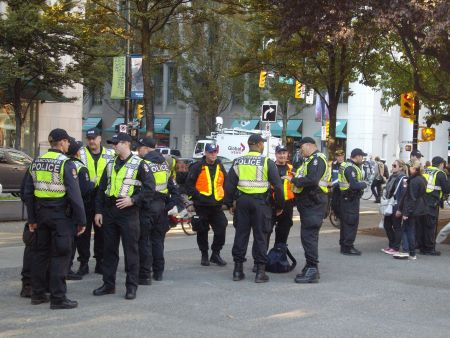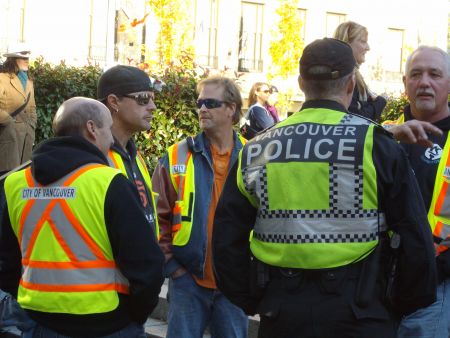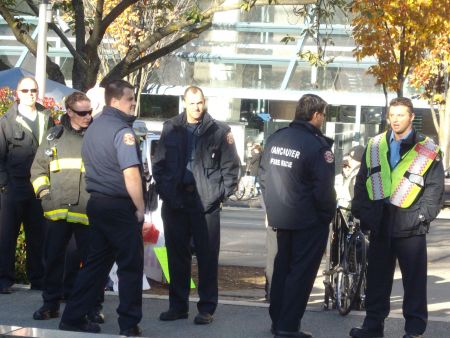STORY about Direct Action posted on October 25, 2011 by Zig Zag
Fear of a Black Bloc Planet
Occupy Vancouver's First Days Occupied by the State
Also posted by Zig Zag:
Also in Direct Action:
On October 15, as part of the global day in solidarity with Occupy Wall Street, an Occupy Vancouver was established at the downtown Vancouver Art Gallery. Between 4,000-5,000 people participated in the first day of rallies and marches. At the same time, the occupation was established with tents, booths and portable toilets on site.
Coming as it did four months to the day after the June 15 Canucks Riot, which caused several million dollars in property destruction and looting, city officials and business were extremely concerned about the Occupy Vancouver mobilization.
Along with opening lines of communication to the initial organizers of Occupy Vancouver, police also began a propaganda campaign against anarchists and 'trouble-makers' who, they warned, would attempt to “hijack” the rally. The greatest fear of local authorities was that a Black Bloc would materialize and carry out attacks.
In the week prior to the rally and encampment, the police and Downtown Vancouver Business Improvement Association (DVBIA) both sent notices to downtown businesses warning them of Occupy Vancouver's plan to set up camp at the Vancouver Art Gallery. Businesses were advised to post security out front of their shops.
On Friday October 14, Vancouver Mayor Gregor Robertson issued a statement on Occupy Vancouver, clearly meant to isolate militants and to divide the movement:
"We know from our experience with the Stanley Cup riots and the protests that marked the start of the Olympic Games that large gatherings can sometimes attract small groups of people determined to use these avenues for their own violent ends... violence, whether against people or property, will not be tolerated and will only detract from those who wish to legitimately express their opinions."
(“Behave yourselves, mayor tells Occupy Vancouver protesters,” ctvbc.ca, Friday Oct. 14, 2011)
The CTV article goes on to explain the police preparations and to present their propaganda. It echoes the mayor's message in its efforts to divide protesters and isolate militants:
“VPD Const. Jana McGuinness told reporters Friday that the police will have a significant presence at Saturday's protest and through the weekend, in order to facilitate lawful protest by an expected several thousand people. She added that VPD members have had positive discussions with organizers of the Occupy Vancouver occupation on the VAG lawn to ensure that the protest can proceed.
“But VPD officers, added McGuinness, will be watching for demonstrators who try to "hi-jack" the event and commit unlawful acts.
“McGuinness said that VPD officers will be looking for protesters who wear masks to hide their identity. The police have learned from previous demonstrations that demonstrators wearing masks end up committing violence, she added.
McGuinness said the VPD is urging protesters to alert police officers to any suspicious or unlawful behaviour by other demonstrators.
"Senior City staff are working closely with the VPD and stakeholders across the community to ensure we are positioned to support a lawful and peaceful protest."
Dave Jones, a former VPD officer who now works as a security consultant for the Downtown Vancouver Business Improvement Association (DVBIA), stated,
“I suspect [police] will have more resources available than there might normally be, just as an added precaution in the event that some people really want to push the point about occupying property, but I can't see it getting too out of hand. The organizers seem to be quite thorough about being peaceful... The big wild card is if the Black Bloc types show up and if they will be allowed into the group. That's what they like to do. They like to hide themselves within a group and then work their way into the main body of protest and then look for opportunities to cause some mayhem. But they might find themselves rejected in this case because it really is a mainstream group of people who are objecting to the amount of wealth accrued by a very small number of individuals and corporations versus the rest of the world and the gap that keeps expanding.”
(“Occupy Vancouver demonstration gains momentum online,” Andrew Fleming, The Vancouver Courier, October 14, 2011)
October 15: Occupy Vancouver Begins
On Saturday Oct. 15 the Vancouver Police Department (VPD) deployed a large number of officers, including its public order unit, motorcycle and bicycle units, as well as Air 1 (a police helicopter shared by the RCMP and municipal police in the region). Along with some 80 cops visible, there were more sequestered away in underground parking facilities at the Hotel Vancouver and BC Law Courts.
Even before the marches began, police focused on a small group of anarchists with black flags that had joined the rally. During the marches, police video cameras followed and filmed this group, even though they wore no masks nor engaged in 'violent' behaviour. The only significant confrontation that occurred resulted from police attempting to clear a lane of traffic on W. Georgia street, bordering the art gallery site. Eventually the entire street was occupied and police resorted to redirecting traffic around it.
Along with the police were scores of City of Vancouver workers, firefighters, and paramedics. While the workers, firefighters and medics were portrayed as ensuring the safety of the protesters, they were in fact another security element working alongside police. In discussions with City of Vancouver workers about why they were there, some explained that they had been instructed to watch out for people wearing masks. Being at the site on a daily basis, the city workers also act as surveillance within the camp, some forming relationships with individual occupiers as well. The city workers and firefighters still remain out in force, although significantly reduced, over one week later.
The use of city workers and emergency services has been seen during large public events, such as the 2010 Olympics and the Canucks' Stanley Cup games. During these events they actually carry out the functions they are intended to do (sanitation, first aid, etc.). The Occupy Vancouver is the first time such personnel have been deployed on such a scale to control a political protest.
Five days after the occupation of the art gallery had begun, the city and media were highlighting the costs resulting from this large deployment of police and other city agencies: nearly half a million dollars, with some $390,000 for policing (mostly from the first day, Oct. 15). To their credit, some of the occupiers who spoke to the media pointed out that they had not asked for police or city workers to attend the rally. Nevertheless, it was the first effort by the city to begin undermining the occupation and mobilizing a right-wing 'backlash' against it. Calls for the camp to be dismantled have been most vocal from the DVBIA and Suzanne Anton, a member of the New Partisan Alliance (NPA) and city councilor. Anton is running for mayor in the November 19 civic election and has been using Robertson's poor performance during the Canucks' riot, as well as Occupy Vancouver, in her campaigning.
The site for the Vancouver local of The Media Co-op has been archived and will no longer be updated. Please visit the main Media Co-op website to learn more about the organization.


